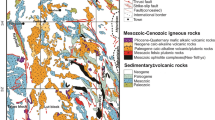Abstract
In this paper the results of a characterization and classification of the mineralogical and chemical composition of some rural soils located close to five clay outcrops that supply the Castellon (spanish province) ceramic industry are presented. A total of 50 sediment samples were collected in accordance with statistical criteria and their chemical and mineralogical composition were determined. The classification of sediment types has been carried out using complementary statistical techniques: a hierarchical cluster analysis using Ward method and Euclidean distance to detect statistical significative groups (clusters) and a discriminant analysis of proximities to obtain probabilities. Univariate statistical descriptions have been computed for all variables. The statistical interpretation of the results suggests the existence of three main groups. Comparisons among them are computed.
Similar content being viewed by others
References
Ballbe, E. and Martinez, S.: 1985, Acta Geol´ogica Hipánica 20(3-4), 245-255.
Carroll, D. and Starkey, H.: 1971, Reactivity of clay minerals with acide and alkalis, Clays and Clay Minerals, 321-33.
Chung, F. H.: 1974, J. Appl. Cryst. 7, 519.
Drits, V. A. and Placon, A.: 1994, Clay Minerals 29, 39.
Gordon, A. D.: 1981, Classification: Methods for the Exploratory Analysis of Multivariate Data, London: Chapman and Hall.
Hair, J. F., Anderson, R. E., Tatham, R. L. and Black, W. C.: 1995, Multivariate Data Analysis with Readings, Fourth Edition, Prentice Hall, New Jersey.
Hartigan, J. A.: 1975, Clustering Algorithms, New York, John Wiley and Sons.
Hathaway, J. C.: 1956, Clay Min. Bull. 3, 8.
Jardine, N. and Sibson, R.: 1971, Mathematical Taxonomy, London, John Wiley and Sons.
Sartori, F. and Tamponi, M.: 1991, Applied Clay Science 6, 121.
Stentiford, M. J.: 1991, Ceram. Eng. Sci. Proc. 12(1-2), 123.
Uhlig, S., Müller, J. and Ulzurrun, J. L: 1995, Bol. Soc. Esp. Ceram y Vidrio 34(1), 29.
Ward, J. H.: 1963, Journal of the American Statistical Association 58, 236.
Author information
Authors and Affiliations
Rights and permissions
About this article
Cite this article
Jordán, M.M., Mateu, J. & Boix, A. A Classification of Sediment Types Based on Statistical Multivariate Techniques. Water, Air, & Soil Pollution 107, 91–104 (1998). https://doi.org/10.1023/A:1004973913426
Issue Date:
DOI: https://doi.org/10.1023/A:1004973913426




